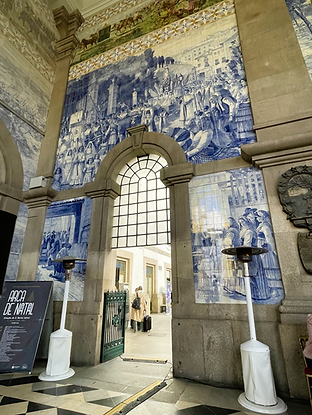Sao Bento Station: Uncovering Porto's Transit Jewel
Disclosure: When you click the ads on this page, I receive compensation that is at no cost to you. The compensation assists me in managing this website’s content free of charge for readers like you. Thank you for your support.


photo from en.wikipedia.org


Embarking on a train journey isn't the sole allure of this locale. Sao Bento Station stands not only as a pivotal entry point to the city but also as a focal point for tourists. It marks the end of the line for Porto's suburban routes and the picturesque Duoro line stretching to and from Pochinho. Recognized as a UNESCO World Heritage Site and a cherished National Monument of Portugal, this station rests just a stone's throw away from the Porto Cathedral and the Clerigos Tower.
Construction
The construction of this grand granite edifice commenced in 1904, reaching completion in 1916, although trains had been arriving as early as 1896 at a provisional Sao Bento station. Crafted according to the blueprints of esteemed Porto architect Jose Marques da Silva, it bears the hallmark of French beaux-arts architecture. The station's foundation lies on the grounds of the former Convent of Sao Bento de Ave-Maria, demolished in 1892. Sao Bento, translating to Saint Benedict, pays homage to its ecclesiastical past.


Azulejo Tiles
The station's crowning glory lies in its extensive panels adorned with approximately 20,000 azulejo tiles, spanning an area of 551 square meters. These masterpieces were conceived and painted by the renowned artist Jorge Colaco, showcasing pivotal moments in the nation's narrative and vibrant rural scenes depicting its diverse populace. A labor of love, the tile project spanned over a decade. The upper reaches of the station are decorated with a broad band of multi-colored tiles, elegantly bordered with hues of blue, brown, and yellow in geometric precision. Adorning the ceilings are ornate friezes, adorned with stylized flowers and a kaleidoscope of hues, chronicling Portugal's transportation evolution alongside depictions of historical events.



Art Canvas on Tiles
Sao Bento Station serves as a canvas for tales of long ago, featuring landscapes and ethnographic vignettes such as the Battle of Valdevez (1140), tributes to luminaries like Prince Henry the Navigator and King Joao I, and commemorations of momentous events like the Conquest of Ceuta (1415). Integrating seamlessly into the station's architecture, these tin-glazed azulejo tiles are encased in granite frames, enhancing the atrium's allure. They are impressive to see.
Nestled amidst Porto's iconic landmarks, Sao Bento Station invites visitors to immerse themselves in its historical tapestry. A mere stroll away from cultural treasures, sparing a few moments to explore its splendor is worth the visit.
